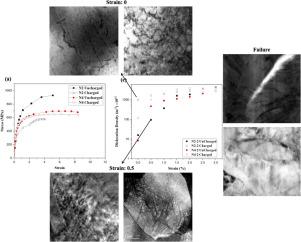Effect of hydrogen on deformation behavior in Ti-Mo and V-Mo precipitate-strengthened steels
IF 2.9
Q2 MATERIALS SCIENCE, MULTIDISCIPLINARY
引用次数: 0
Abstract
Recent studies show that precipitate-strengthened microalloyed steels offer strong resistance to hydrogen embrittlement due to hydrogen trapping by nanoscale precipitates. This study investigates how these precipitates interact with dislocations under strain, simulating service conditions. Two model steels were used: Ti-Mo steel with coherent (Ti,Mo)C precipitates and V-Mo steel with semi-coherent (V,Mo)C precipitates. Dislocation density was measured during in-situ neutron diffraction tensile tests, with and without hydrogen charging. Hydrogen increased dislocation density before straining but suppressed dislocation multiplication during loading, reducing overall dislocation strengthening, especially in Ti-Mo steel. The Ti-Mo steel showed greater sensitivity to hydrogen, attributed to reversible hydrogen trapping at coherent precipitate interfaces, and a greater increase in dislocation density. In contrast, V-Mo steel exhibited more irreversible trapping and a smaller increase in dislocation density. During tensile testing, with reversible hydrogen released to diffuse, subgrain formation in Ti-Mo steel was restricted, as the higher concentration of diffusible hydrogen suppressed screw dislocation mobility. Consequently, fewer subgrain microstructures were generated, diminishing their effectiveness as barriers to crack propagation in Ti-Mo steel, compared to V-Mo steel. These results highlight the importance of selecting precipitate types that enhance irreversible hydrogen trapping, thereby improving the hydrogen resistance of steels.

氢对Ti-Mo和V-Mo析出强化钢变形行为的影响
最近的研究表明,由于纳米级析出物捕获氢,沉淀强化微合金钢具有很强的抗氢脆性能。本研究探讨了这些沉淀如何在应变下与位错相互作用,模拟使用条件。采用两种模型钢:具有(Ti,Mo)C析出相的Ti-Mo钢和具有半相干(V,Mo)C析出相的V-Mo钢。在原位中子衍射拉伸试验中,在充氢和不充氢的情况下测量了位错密度。氢在应变前增加位错密度,但在加载过程中抑制位错增殖,降低了整体位错强化,尤其是在Ti-Mo钢中。Ti-Mo钢对氢表现出更大的敏感性,这是由于在共格析出界面上可逆的氢捕获,并且位错密度增加更大。相反,V-Mo钢表现出更多的不可逆捕获和较小的位错密度增加。在拉伸试验中,可逆氢释放扩散,抑制了Ti-Mo钢中亚晶粒的形成,因为较高浓度的扩散氢抑制了螺位错的迁移率。因此,与V-Mo钢相比,Ti-Mo钢中产生的亚晶组织较少,降低了它们作为裂纹扩展障碍的有效性。这些结果强调了选择增强不可逆氢捕获的沉淀类型的重要性,从而提高钢的抗氢性能。
本文章由计算机程序翻译,如有差异,请以英文原文为准。
求助全文
约1分钟内获得全文
求助全文
来源期刊

Materialia
MATERIALS SCIENCE, MULTIDISCIPLINARY-
CiteScore
6.40
自引率
2.90%
发文量
345
审稿时长
36 days
期刊介绍:
Materialia is a multidisciplinary journal of materials science and engineering that publishes original peer-reviewed research articles. Articles in Materialia advance the understanding of the relationship between processing, structure, property, and function of materials.
Materialia publishes full-length research articles, review articles, and letters (short communications). In addition to receiving direct submissions, Materialia also accepts transfers from Acta Materialia, Inc. partner journals. Materialia offers authors the choice to publish on an open access model (with author fee), or on a subscription model (with no author fee).
 求助内容:
求助内容: 应助结果提醒方式:
应助结果提醒方式:


